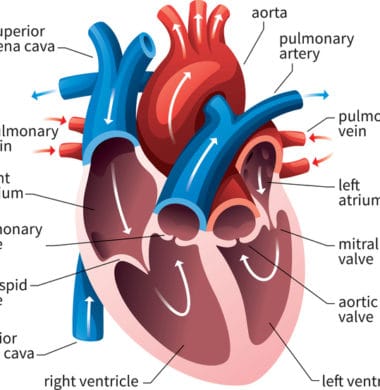Mitral Valve Prolapse – What is MVP

What is Mitral Valve Prolapse?
The mitral valve is found between the left atrium and left ventricle of the heart and allows the oxygenated blood to flow through the heart. Occasionally the valve will not provide a strong enough seal between the two chambers. One example of this would be called a mitral valve prolapse.
Mitral valve prolapse, or MVP occurs when the valve slips up into the left atrium when the heart contracts. MVP occurs in about two percent of the population and can be genetic or caused by other health problems. Though mitral valve prolapse is not life threatening, it can occasionally lead to more serious health issues including, mitral valve regurgitation, arrhythmia, or endocarditis.
What are the Symptoms of Mitral Valve Prolapse?
Symptoms are not always present, though common symptoms include, a racing or irregular heartbeat (arrhythmia), dizziness or lightheadedness, difficulty breathing or shortness of breath often when lying flat or during physical activity, fatigue, or chest pain. MVP can cause a heart murmur, which is often the starting point for a doctor to diagnose a patient. Once the doctor hears a murmur, they will suggest an echocardiogram, which will measure how well the heart pumps with each beat and determine how much blood may be leaking from the valve. Once it is determined that the patient has a MVP, the cardiologist will need to determine the severity of the prolapse. Many minor MVP do not always require medical attention. If a patient is experiencing any of the symptoms of MVP it is suggested that they pursue a cardiac evaluation.
One of the complications that can arise from a MVP is mitral valve regurgitation. This occurs when the valve does not completely close, thus allowing the oxygenated blood to leak back into the left atrium. As this problem occurs over time it will cause more stress to the heart if left untreated, as the heart will have to work harder to distribute blood. The treatment of mitral valve regurgitation depends on the severity of the leakage into the left atrium of the heart. Similar to the symptoms of a MVP, a mitral valve regurgitation can be present without symptoms. Though the symptoms may vary depending on the severity of the condition they can manifest as a heart murmur, shortness of breath when active or lying down, fatigue, heart palpitations, or swollen feet and ankles. There are several possible causes of mitral valve regurgitation which are not limited to MVP, damaged tissue cords, endocarditis, heart attack, cardiomyopathy, congenital heart defects, certain drugs, radiation therapy or atrial fibrillation. The severity of the mitral regurgitation will dictate the treatment suggested by a cardiologist. There are no medicines that can be prescribed for the correcting of the valve, only the treatment of the symptoms. Severe mitral valve regurgitation can be corrected surgically through open heart valve replacement or repair as well as trans-catheter valve repair. The mitral valve can be replaced or repaired in patients that are good candidates for surgery. The surgery can take place through an incision in the chest or a minimally invasive surgery through smaller incisions. The surgeon will go in and repair the valve, whether it is through tightening the valve closure or tightening the tissue cords that control the movement of the valve. When it comes to completely replacing the mitral valve, the surgeon will remove the valve and replace it with a mechanical valve or a biological tissue valve. The treatment of mitral valve regurgitation is an area of study, especially in the case of patients who are not good candidates for surgery. One solution that has become more prominent is the use of a catheter procedure and a device called mitraclip.
The mitraclip procedure is a newer procedure that uses a catheter place in the large vein in the groin and maneuvered to the heart. A small tool at the end of the catheter creates a small hole into the left atrium. Once the catheter is placed, an ultrasound allows the doctor to place the mitraclip on the valve leaflets, effectively clamping the center of the leaflets together. Once the clip is placed, the doctor will note how the blood is flowing and can re-position the clamp to guarantee minimal leakage. The benefits of this procedure are focused around the quick recoup time and that it is less invasive than open heart surgery. This is also an excellent option to be considered for patients who may not be good candidates for open heart surgery.
- 9 Tips to Reduce Holiday Stress - December 11, 2025
- 6 Tips for Exercising Outdoors with a Heart Condition - May 19, 2025
- Lifestyle Changes That Can Help Manage Arrhythmia - April 30, 2025
Learn More about MVP and treatment options here
With advanced minimally invasive therapies, our Structural Heart Clinic at South Denver Cardiology arranges care around four different heart valve procedures.
Learn more
